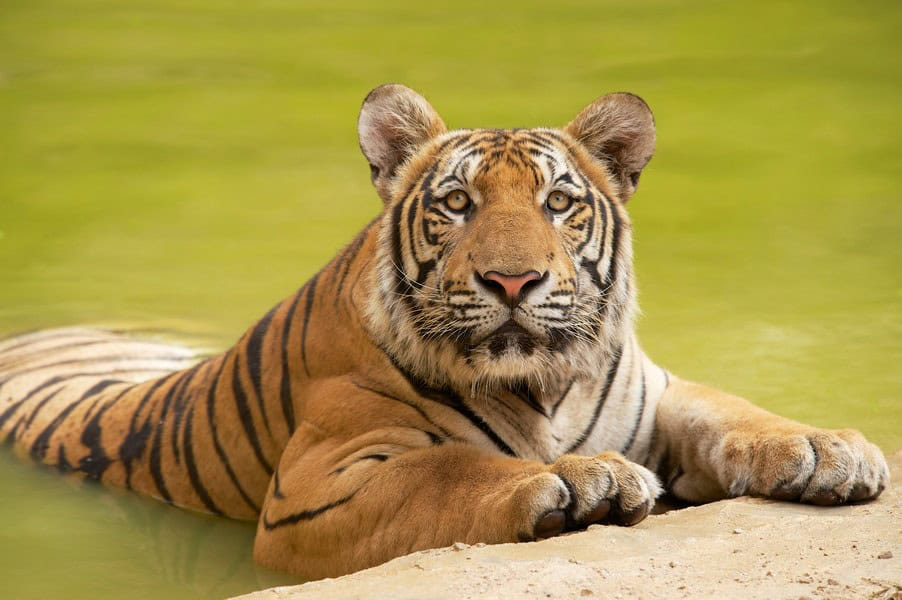
There are nine different types of tigers. Each subspecies is adapted to specific habitats and each has its own set of behavioral patterns and dietary preferences.
- Bengal Tiger
- Indochinese Tiger
- Malayan Tiger
- Siberian Tiger
- South China Tiger (Critically Endangered)
- Sumatran Tiger (Critically Endangered)
- Caspian Tiger (Extinct)
- Bali Tiger (Extinct)
- Javan Tiger (Extinct)
The Evolution of Tigers
Tigers belong to the genus Panthera within the family Felidae. This lineage of carnivores have evolved for over 2 million years. Early tiger ancestors were solitary hunters inhabiting dense forests and grasslands. They have expanded their range to various habitats, including tropical rainforests, temperate forests, and even snowy landscapes.

Equipped with a poweful build, retractable claws and sharp teeth, tigers are effective hunters as well as apex predators. They can reach speeds of 40 mph (64 km/h) in short bursts, leap 30 feet (9 m), and move silently thanks to padded feet. Their night vision is six times better than a human’s, while acute hearing and a strong sense of smell help them locate prey.
Tiger stripes are a form of camouflage. The black stripes break up the tiger’s body outline. Although their bright orange fur seems to stand out to humans, their prey doesn’t see it the same way. Deer and other typical prey animals have dichromatic vision. This means they see a limited spectrum of colors and can’t differentiate orange from green or brown. In other words, a tiger’s orange coat looks like another earth tone, allowing it to blend in with grass, forests, and shadows.
9 Types of Tigers
Bengal Tiger

The Bengal tiger is the most numerous tiger subspecies. It is primarily found in India, with smaller populations in Bangladesh, Nepal, and Bhutan. These cats typically measure 8 to 10 feet (2.5 to 3 meters) in length and weigh between 400 to 570 pounds (180 to 260 kilograms). Bengal tigers inhabit a variety of environments, including mangroves, grasslands, and forests. Their diet consists mainly of large ungulates such as deer and wild boar.
Indochinese Tiger

The Indochinese tiger is found in Southeast Asia. They live in Cambodia, Laos, Myanmar, Thailand, and Vietnam. These tigers typically measure 8 to 9 feet (2.4 to 2.7 meters) in length and weigh between 300 to 500 pounds (136 to 227 kilograms). Indochinese tigers prefer dense tropical forests and mountainous regions. Their coat is generally lighter with fewer stripes compared to Bengal tigers.
Malayan Tiger

The Malayan tiger is native to the Malay Peninsula in Malaysia. These tigers are slightly smaller, measuring 7 to 8 feet (2.1 to 2.4 meters) in length and weighing between 220 to 310 pounds (100 to 140 kilograms). Malayan tigers inhabit tropical rainforests and are capable climbers. Their diet primarily includes sambar deer, wild boar, and other medium-sized ungulates.
Siberian Tiger

The Siberian tiger, also known as the Amur tiger, is the largest tiger subspecies, found primarily in the Russian Far East, with small populations in China and North Korea. These tigers can grow up to 10 feet (3 meters) in length and weigh between 400 to 700 pounds (180 to 318 kilograms). Adapted to cold climates, Siberian tigers have thick fur and a layer of fat to insulate against harsh winters. They inhabit boreal forests and mountainous regions and feed on ungulates such as deer and wild boar.
South China Tiger (Critically Endangered)

The South China tiger is one of the most critically endangered tiger subspecies, possibly extinct in the wild. Historically found in the mountainous regions of southern China, these tigers measure 7 to 8 feet (2.1 to 2.4 meters) in length and weigh between 220 to 310 pounds (100 to 140 kilograms). They prefer dense subtropical forests and primarily feed on deer and wild boar. Due to extensive habitat loss and poaching, the South China tiger population is essentially gone. Only about 50 individuals are left, all of which are in captivity.
Sumatran Tiger (Critically Endangered)

The Sumatran tiger is the smallest tiger subspecies, endemic to the island of Sumatra in Indonesia. These tigers measure 6 to 7 feet (1.8 to 2.1 meters) in length and weigh between 220 to 310 pounds (100 to 140 kilograms). Sumatran tigers inhabit tropical rainforests. Their diet includes sambar deer, wild boar, and primates. The Sumatran tiger population is critically endangered, with an estimated 600 left in the wild. Intense conservation efforts are underway to prevent their extinction.
Caspian Tiger (Extinct)

The Caspian tiger once roamed the regions around the Caspian Sea, including parts of Turkey, Iran, Central Asia, and the Caucasus. These tigers measured up to 9 feet (2.7 meters) in length and weighed between 400 to 500 pounds (180 to 227 kilograms). Adapted to temperate and semi-arid climates, Caspian tigers lived in forests, grasslands, and riverine areas. Unfortunately, relentless hunting for their prized fur and widespread habitat destruction pushed the species to extinction. The last confirmed sighting was in 1974, and they were officially declared extinct in 2003.
Bali Tiger (Extinct)

The Bali tiger was a subspecies endemic to the Indonesian island of Bali. These tigers were smaller, measuring around 6 feet (1.8 meters) in length and weighing approximately 220 pounds (100 kilograms). Bali tigers inhabited dense forests and mountainous regions, preying on wild boar and deer. Their population faced severe declines in the early 20th century due to habitat loss, hunting, and human encroachment. The Bali tiger was declared extinct in the 1940s, marking the first tiger subspecies to disappear in modern times.
Javan Tiger (Extinct)

The Javan tiger was native to the Indonesian island of Java. These tigers were similar in size to the Sumatran tigers, measuring 6 to 7 feet (1.8 to 2.1 meters) in length and weighing between 220 to 310 pounds (100 to 140 kilograms). Javan tigers inhabited tropical forests, where they hunted deer, wild boar, and small mammals. Deforestation, habitat fragmentation, and hunting pressure led to their rapid decline. The last official sighting was recorded in 1976 and they were declared as extinct in 2008.
Are There Any Tigers in Africa?
Today, Africa lacks a native tiger population. Fossil evidence suggests that their ancestors originated in the region of modern-day China and Siberia, spreading throughout Asia over millions of years. Tigers never expanded their range into Africa due to natural barriers, such as deserts and seas. Furthermore, the ecosystems of Africa are dominated by other large predators such as lions, leopards, and cheetahs, which occupy the ecological niches that tigers might have otherwise filled.
Prehistoric Tigers

The saber-toothed tiger, or Smilodon fatalis, is one of the most famous prehistoric predators. Their defining feature was their elongated canine teeth, which could grow up to 11 inches (28 cm) long. These teeth were specialized for delivering precise, fatal bites to the soft throats or bellies of their prey.
Saber-toothed tigers inhabited regions across North and South America, where they hunted large herbivores such as bison and mammoths. Compared to modern day tigers, saber-toothed tigers were more muscular and stocky, adapted for grappling with large prey. They weighed up to 620 pounds (280 kg).
Evidence suggests that saber-toothed tigers may have lived in groups, similar to modern lion prides, but this theory is still debated among scientists.

Another interesting prehistoric tiger is the Longdan tiger, or Panthera zdanskyi. This species was larger than the modern Siberian tigers, measuring up to 10 feet (3 meters) in length and weighing between 600 to 1,200 pounds (272 to 544 kilograms).
Longdan tigers possessed thick fur and robust bodies, allowing it to withstand the cold environment of prehistoric Alaska. Fossil evidence suggests that these tigers were highly adaptable, capable of hunting a variety of prey, from marine mammals to terrestrial ungulates.




























































